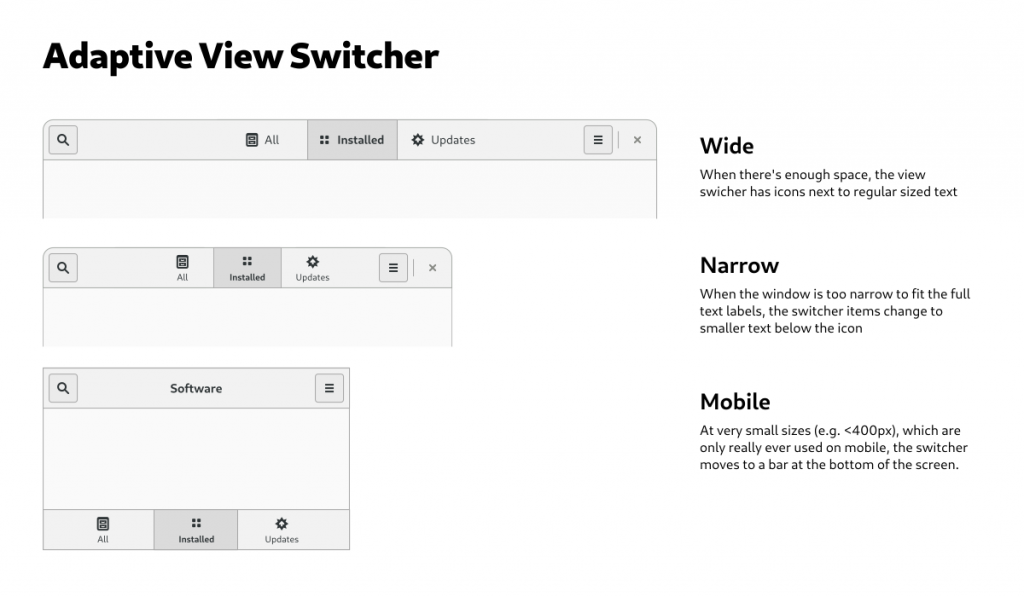The New libhandy 0.0.10
Purism
Latest posts by Purism (see all)
- A Quarter Century After Cyberselfish, Big Tech Proves Borsook Right - December 20, 2025
- PureOS Crimson Development Report: November 2025 - December 15, 2025
- Purism Liberty Phone Exists vs. Delayed T1 Phone - December 10, 2025
Libhandy 0.0.10 just got released, and you can get this new version here. It comes with a few new adaptive widgets for your GTK app we’d like to tell you about:
The View Switcher
GNOME applications typically use a GtkStackSwitcher to switch between their views. This design works fine on a desktop, but not so well on really narrow devices like mobile phones, so Tobias Bernard designed a more modern and adaptive replacement – now available in libhandy as the HdyViewSwitcher:
In many ways, the HdyViewSwitcher functions very similarly to a GtkStackSwitcher: you assign it a GtkStack containing your application’s pages, and it will display a row of side-by-side, homogeneously-sized buttons, each one representing a page. It differs in that it can display both the title and the icon of your pages, and that the layout of the buttons automatically adapts to a narrower version, depending on the available width. We have also added a view switcher bar, designed to be used at the bottom of the window: HdyViewSwitcherBar (and we’d like to thank Zander Brown for the prototypes!).
The Squeezer
To complete the view switcher design, we needed a way to automatically switch between having a view switcher in the header bar, and a view switcher bar at the bottom of the window.
We added HdySqueezer; give it widgets, and it shows the first one that fits in the available space. A common way to use it would be:
<object class="GtkHeaderBar">
<property name="title">Application</property>
<child type="title">
<object class="HdySqueezer">
<property name="transition-type">crossfade</property>
<signal name="notify::visible-child" handler="on_child_changed"/>
<child>
<object class="HdyViewSwitcher" id="view_switcher">
<property name="stack">pages</property>
</object>
</child>
<child>
<object class="GtkLabel" id="title_label">
<property name="label">Application</property>
<style>
<class name="title"/>
</style>
</object>
</child>
</object>
</child>
</object>
In the example above, if there is enough space the view switcher will be visible in the header bar; if not, a widget mimicking the window’s title will be displayed. Additionally, you can reveal or conceal a HdyViewSwitcherBar at the bottom of your window, depending on which widget is presented by the squeezer, and show a single view switcher at a time.
Another Header Bar?
To make the view switcher work as intended, we need to make sure it is always strictly centered; we also need to make sure the view switcher fills all the height of the header bar. Both of these are unfortunately not possible with GtkHeaderBar in GTK 3, so I forked it as HdyHeaderBar to, first, make sure it does not force its title widget to be vertically centered, and hence to allow it to fill all the available height; and second, to allow for choosing between strictly or loosely centering its title widget (similarly to GtkHeaderBar).
The Preferences Window
To simplify writing modern, adaptive and featureful applications, I wrote a generic preferences window you can use to implement your application’s preferences window: HdyPreferencesWindow – and organized it this way:
• the window contains pages implemented via HdyPreferencesPage;
• pages have a title, and contain preferences groups implemented via HdyPreferencesGroup;
• groups can have a title, a description, and preferences implemented via rows (HdyPreferencesRow) or any other widget;
• preferences implemented via HdyPreferencesRow have a name, and can be searched via their page title, group title or name;
• HdyActionRow is a derivative of HdyPreferencesRow, so you can use it (and its derivatives) to easily implement your preferences.
The next expected version of libhandy is libhandy 1.0. It will come with quite a few API fixes, which is why a major version number bump is required. libhandy’s API has been stable for many versions now, and we will guarantee that same stability starting from version 1.0.
Recent Posts
Related Content
- PureOS Crimson Development Report: November 2025
- PureOS Crimson Development Report: October 2025
- Landfall: A Case Study in Commercial Spyware
- Consent On Everything?
- 60 Minutes Uncovers Hacks on America’s Infrastructure


